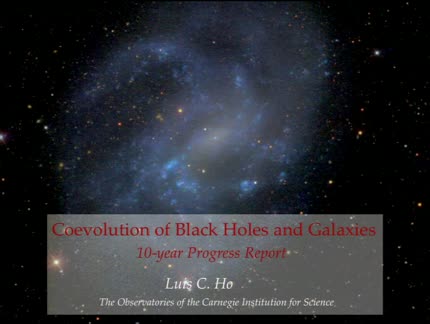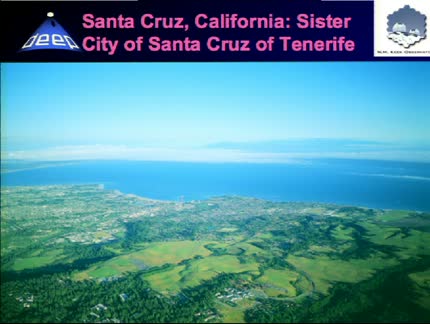Found 30 talks width keyword star forming galaxies

Abstract
Supermassive black holes are ubiquitous in galaxies and play a fundamental role in their life cycle. I will review observational progress in defining and refining the various empirical scaling relations between black hole masses and host galaxy properties. I will emphasize ways in which the intrinsic scatter of the scaling relations can be quantified, and present evidence that the scatter correlates with physical properties. I will describe how the scaling relations can be extended to active galaxies and summarize preliminary efforts to probe the evolution of these scaling relations with redshift. I will present new measurements of the cold ISM content in AGN host galaxies and constraints they place on currently popular models of AGN feedback. Lastly, I will discuss a new class of low-mass black holes in bulgeless and dwarf galaxies that serve as local analogs of seed supermassive black holes.

Abstract
Luminous Infrared Galaxies (LIR=10^11-10^12Lsun) have star formation rates in the range of ~20-200Msun/yr. In the local Universe ~50% LIRGs show AGN or AGN/SB composite nuclear activity from optical spectroscopy. We decompose Spitzer/IRS 5-35micron spectra of a complete sample of 50 local (d<75Mpc) LIRGs using SB and AGN clumpy torus model templates. We derive a mid-IR AGN detection rate in our sample of local LIRGs of 50%. We also compare the continuum mid-IR AGN detection with other indicators in the mid-IR, optical and X-rays. We estimate for the first time the AGN bolometric contribution to the IR luminosity of the galaxies in local LIRGs. We find that one-third of local LIRGs have LAGN(bol)/LIR>0.05, with only ~10% having a significant contribution LAGN(bol)/LIR>0.25. This is in line with results of Nardini et al. (2010) that only at LIR>3x10^12Lsun the AGN starts dominating bolometrically the IR luminosity in the majority of the systems.

Abstract
We present the detailed Star Formation History of the nearby Sculptor and Fornax dwarf spheroidal galaxies, from wide-field photometry of resolved stars, going down to the oldest Main Sequence Turn-Off. The accurately flux calibrated, wide-field Colour-Magnitude Diagrams are used directly in combination with spectroscopic metallicities of individual RGB stars to constrain the ages of different stellar populations, and derive the Star Formation History with particular accuracy.
The detailed Star Formation History shows the star formation at different ages and metallicities, at different positions in the galaxy, and shows that the known metallicity gradients are well matched to an age gradient. The obtained SFH is used to determine accurate age estimates for individual RGB stars, for which spectroscopic abundances (alpha-elements, r- and s-process elements) are known. In this way, we obtain the accurate age-metallicity relation of each galaxy, as well as the temporal evolution of alpha-element abundances.
This allows us to study, for the first time, the timescale of chemical evolution in these two dwarf galaxies, and determine an accurate age of the "knee" in the alpha-element distribution. Finally, we compare the timescale of chemical evolution in both dwarf galaxies, and determine whether the chemical abundance patterns seen in galaxies with recent episodes of star formation are a direct continuation of those with only old populations.

Abstract
When we measure the electron density within an H II region using ratios of emission lines we find characteristic values in the range of 100-300 cm-3. But when we make these measurements using the total luminosity in Hα and the overall radial size of an H II region we find average values in the range 3-10. I will first explain how this discrepancy occurs, and then go on to show some measurements of electron densities in the H II regions of M51 (over 2500 regions) and the dwarf galaxy NGC 4449 (over 250 regions) using the second method, by Leonel Gutiérrez and myself. From these measurements we can infer how the electron density varies with the radial size of an individual region, and how it varies as we move from the center of the galaxy disc to the outside. Some interesting simple global relationships are found, which tell us about the interaction of star forming regions with their surroundings and how this interaction varies across the face of a galaxy.
Abstract
AEGIS (All-wavelength Extended Groth strip International Survey: aegis.ucolick.org) is on-going survey that opens up new views of the development of galaxies and AGN's at redshifts z about 1. AEGIS is panchromatic like GOODS, with coverage ranging from X-ray to radio, and nearly as deep but more panoramic by covering a 4x larger region. Its backbone is the most Northern (accessible to the GTC) of the four fields of the DEEP2 Keck spectroscopic survey, which provides not only precision redshifts that yield reliable pairs, groups, and environments, but also internal kinematics and chemical abundances. After an overview of the DEEP and AEGIS surveys, I will share some recent highlights, including using a new kinematic measure for distant galaxies to track Tully-Fisher-like evolution; discovering metal poor, massive, luminous galaxies; finding ubiquitous galactic gas outflows among distant star forming galaxies; and exploring the nature of distant x-ray AGNs.
Abstract
In the local universe, galaxies fall into one of two populations: a star-forming blue cloud and a red sequence lacking star formation. At redshift z ~ 1.5, however, the red sequence has yet to develop. Over the past 9 Gyrs some process has quenched star formation in blue galaxies and caused them to evolve onto the red sequence by fading and/or merging of their stellar populations. While such a transformation may be occurring across the full range of masses, the highest rate of evolution occurs in massive starbursts at the luminous end of the blue cloud. These galaxies are the Luminous Compact Blue Galaxies (LCBGs). In this talk I present preliminary results of a comprehensive multiwavelength survey of LCBGs from z ~ 0 to z ~ 3 we will be carrying out over the next 5 years using several space and ground-based observatories, including the GTC.

Abstract
Long gamma-ray bursts are supposed to be connected to the death of very massive stars. Due to their brightness, we can detect them to much larger distances than supernovae. Using them as powerful lightsources, they allow us to study star-forming high redshift galaxies and their interstellar medium in great detail with medium and high resolution spectroscopy. Despite the large redshift ranged spanned by GRBs, there is surprisingly little evolution in the properties of their host galaxies which might indicate that GRBs can only occur under certain conditions. This can be investigated from a few bursts at very low redshifts where we can resolve their host galaxies e.g. with integral field spectroscopy. The immediate surroundings might allow us some conclusions on the progenitors of GRBs.

Abstract
The colour distribution of globular cluster (GC) systems in the majority of galaxies is bi/multimodal in optical colours. It is widely accepted that multiple populations differing in metallicity exist implying different mechanisms/epochs of star formation, with small age differences still being allowed due to the large current uncertainties. Recently Yoon, Yi and Lee (2006) challenged this interpretation stating that the metallicity bimodality is an artifact of the horizontal branch (HB) morphologies that can transform a unimodal metallicity distribution in a bimodal (optical) colour distribution. The combination of optical and near-infrared (NIR) colours can in principal break the age/metallicity degeneracy inherent in optical colours alone, allowing age estimates for a large sample of GCs possible at the same time. It has been shown that the colours that best represent the true metallicity distributions are the combination of optical and NIR (eg. Puzia et al. 2002, Cantiello & Blakeslee 2007). Therefore studying GCs in the NIR is crucial to reveal their true metallicity distributions. We are currently building a homogeneous optical/NIR data set of GC systems in a large sample of elliptical and lenticular galaxies. I will present the sample, an attempt to estimate overall ages and metallicities for the GC systems and the optical/NIR colour distributions.
Abstract
(1) We present SAURON integral-field stellar velocity and velocity dispersion maps for four double-barred early-type galaxies: NGC2859, NGC3941,NGC4725 and NGC5850. The presence of the nuclear bar is not evident from the radial velocity, but it appears to have an important effect in the stellar velocity dispersion maps: we find two sigma-hollows of amplitudes between 10 and 40 km/s at either sides of the center, at the ends of the nuclear bars. We have performed numerical simulations to explain these features. Ruling out other possibilities, we finally conclude that, although the sigma-hollows may be originated by a younger stellar population component with low velocity dispersion, more likely they are an effect of the contrast between two kinematically different components: the high velocity dispersion of the bulge and the ordered motion (low velocity dispersion) of the nuclear bar.(2) We have explored radial color and stellar surface mass density profiles for a sample of 85 late-type galaxies with available deep (down to ~27.0 mag/arcsec2 SDSS g'- and r'-band surface brightness profiles. About 90% of the light profiles have been classified as broken exponentials, exhibiting either truncations (Type II galaxies) or antitruncations (Type III galaxies). Their associated color profiles show significantly different behavior. For the truncated galaxies a radial inside-out bluing reaches a minimum of (g' - r') = 0.47 +/- 0.02 mag at the position of the break radius, this is followed by a reddening outwards. The anti-truncated galaxies reveal a more complex behavior: at the break position (calculated from the light profiles) the color profile reaches a plateau region - preceded with a reddening - with a mean color of about (g' - r') = 0.57 +/- 0.02 mag. Using the color to calculate the stellar surface mass density profiles reveals a surprising result. The breaks, well established in the light profiles of the Type II galaxies, are almost gone, and the mass profiles resemble now those of the pure exponential Type I galaxies. This result suggests that the origin of the break in Type II galaxies are most likely to be a radial change in stellar population, rather than being caused by an actual drop in the distribution of mass. The anti-truncated galaxies on the other hand preserve their shape to some extent in the stellar surface mass density profiles. We find that the stellar surface mass density at the break for truncated (Type II) galaxies is 13.6 +/- 1.6 Msun/pc2 and 9.9 +/- 1.3 Msun/pc2 for the anti-truncated (Type III) ones. We estimate that ~15% of the total stellar mass in case of Type II galaxies and ~9% in case of Type III galaxies are to be found beyond the measured break radii.

Abstract
I will present results from a survey of the star formation properties of nearby galaxies, using H alpha narrow-band imaging. The first half of the talk will cover the `expected' results of such a survey: how total star formation rates depend on galaxy morphology, the contribution of different types to the global star formation activity per unit volume of the nearby Universe, constraints on star formation histories, and indications of how stellar mass has been assembled in disks from the spatial distributions of young and old stars. The second half will look at some less expected spin-offs, including some surprising facts about the Magellanic Clouds, and new findings on progenitors of core-collapse supernovae.<< First « Newer 1 | 2 | 3 Older »
Upcoming talks
- TODAY: Classical Be stars - Constraining binary interaction physics in massive starsDr. Julia BodensteinerThursday April 25, 2024 - 10:30 GMT+1 (Aula)
- Runaway O and Be stars found using Gaia DR3, new stellar bow shocks and search for binariesMar Carretero CastrilloTuesday April 30, 2024 - 12:30 GMT+1 (Aula)









